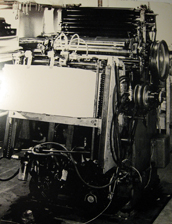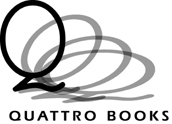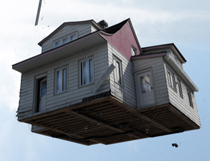Celebrating the Novella
Amatoritsero Ede in Conversation with John Calabro
 Amatoritsero Ede: Is it correct to assume that Quattro does not have an in-house press?
Amatoritsero Ede: Is it correct to assume that Quattro does not have an in-house press?
John Calabro: Yes, it does not. We have our books printed with Marquis in Quebec, they are very progressive and do a great job.
A.E.: Could you give us details about the pre-press stage of your publishing process – that is, up to the point where the external printer takes over?
J.C.: Once the manuscript has been copy-edited, it goes to layout. At the same time we try different images for the cover. Once the cover image has been chosen it goes to our cover designer. When we get the manuscript back from layout we have three or four proof-readers that look at the manuscript and suggest changes, or fix obvious spelling and grammatical errors as well as typographical errors. The typographer makes all the changes. The manuscript comes back to me and I check it one last time. Meanwhile the cover designer has finished with the cover, adjusted the spine for page count and proofread it. The cover is also sent it to me for one last check. I approve both and send the files to the printer. The galleys from the printers come back to me and are also looked at by the author, and the editor of that particular manuscript. Once approved by them, I give the go-ahead for printing.
A.E.: How do you monitor the production process to make sure your specifications are followed?
J.C.: We check and check and re-check at every point of the process. And even at that, when you juggle 16-18 manuscripts a year, and are a small understaffed press, things do slip by. We try our best to have a goal of zero typos for every book. We are getting very close to that goal and are proud of it. Quality of production is important to us.
A.E.: …This might seem rather obvious but it would give our lay readers insights if they know how you decide what kind of printer is suitable for particular print jobs?
J.C.: We originally went with a reputable printer that was suggested to us by other presses, Marquis Imprimeur. We were enticed to change printers by lower printing costs, and it was a big mistake. The quality was just not there. We went back to our original printers and are very happy to pay a bit more for better quality.
A.E.: The transition from analogue to digital book production process was rapid in the last part of the 20th century, and dramatic in the 21st. In what percentages do u mix analogue processes and the digital? I refer specifically to pre-press work. Lets think in terms of Desktop-Publishing-application-mediated Computer to Plate (CTP) instead of the old Computer to Film (CTF) Process. For a small and specialized press like Quattro is there any advantage in 21st century Publish on Demand technology; would you consider engaging the Expresso Book Machine?
J.C.: Of course we would. Our goal is to disseminate out titles to the largest readership possible, while having a profit margin that sustains the company and maintains its growth. We have no prejudices against any of the new forms. To us it is not the format that is important but the content. We just have to be careful that we do not scavenge our print format. We want to make sure that we cater to different readers and give them the format they prefer.
A.E.: What new technologies of production or dissemination (i.e. reading) do you incorporate into your operations?
J.C.: I am not sure I understand the question. We try to place our titles with reviewers, whether they are working for print, radio, television, or on-line media. We send to literary blogs. We launch our books in different cities and try to place our authors in literary festivals and reading series.
A.E.: Naturally one would assume that offset publishing technique results in better quality than POD technology. Would you say this is an accurate summation?
J.C.: Yes it is, but with technology improving so quickly, for typical literary prose and poetry print runs, which we mostly publish, the difference in quality is minimal. Colour production is different, and we always go offset for that.
A.E.: How would a POD technology like Expresso Book Machine be advantageous, if at all?
J.C.: As I said in a previous answer, it makes our titles accessible to readers and buyers on a timely and efficient way, and thus creating a sale that may not happen otherwise. It is particularly good for backlists.
A.E.: Do you think technology will ever get so far as to completely short-circuit the offset/litograph printing towards the end product?
J.C.: Not completely, there will simply be an array of choices for publishers that were not available before. What is important to watch is the mix of these formats, and the trends developing as to what the future mix will be.
A.E.: The novella, which is your province, is a very powerful form in capable hands as exemplified in little classics like Heart of Darkness – lets forget its ideological problematic for a minute, Of Mice and Men, The Old Man and the Sea, Dr. Jekyll and Mr. Hyde, or Animal Farm, to mention a few. In your operations have you found justification for promoting this form in Canada?
J.C.: The only justification that we need is that it is a format that has nourished literature in the past and keeps doing it. It is mostly ignored in English Canada. See attached a small lecture I give on the novella.
A.E.: How many novellas have you published in your imprint, and what impact do you think they are having on Canadian literature?
J.C.: We have produced 25 contemporary novellas; we are translating one contemporary novella Contre Dieu by Patrick Senecal and one out of print novella by Hubert Aquin, both French-Canadians, and re-issuing, Joanna, a novella by Marian Engel.
A.E.: What difference would you say Quattro has had on Canadian publishing since its appearance in 2006?
J.C.: We have brought the writing, publishing and promoting of the novella front and center in the Canadian literary discussion. And we are just starting; we want to pursue an aggressive publishing program to translate French-Canadian novellas, both classic and contemporary, and also to translate novellas from foreign languages into English. We get about 80 novella submissions per year. People have now begun to write novellas just for us, since they know there is a market of them.
A.E.: Finally in how far would you say Canadian arts organisations like Canada Council, or Ontario Media Development Corporation and so on helped you and are helping a specialised small press like Quattro reach its goals?
J.C.: Those organizations and the OAC as well as the Book fund are integral for the survival of the book publishing industry in Canada. Without them there would not be a Canadian publishing industry. Of course, it comes at a price, in terms of some freedom to publish, how, what and in what numbers, but it is a small price. As a small publisher we could not survive without them. We are indebted to them.
A.E.: Thank you for taking time off your busy schedule.






No Comments so far ↓
There are no comments yet...Kick things off by filling out the form below.